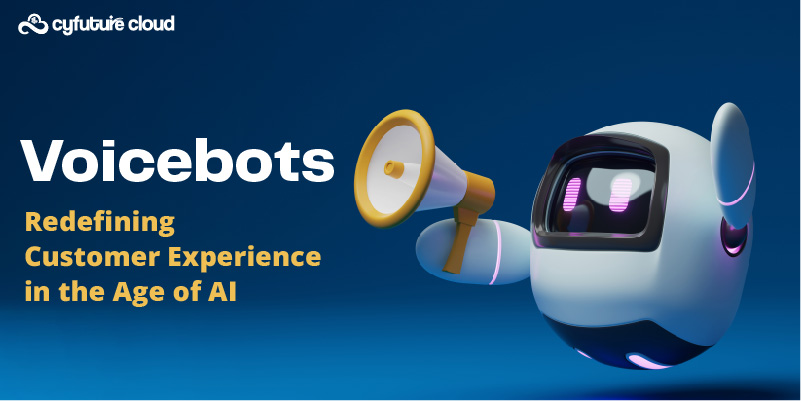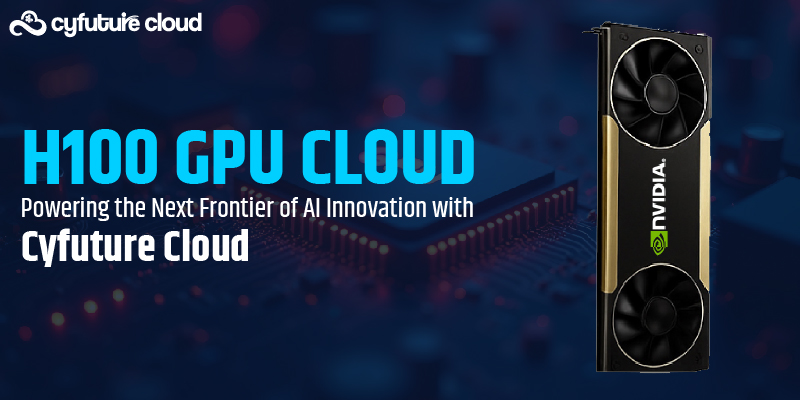Table of Contents
Did you know the global AI market will reach $190 billion by 2025? As the world becomes increasingly reliant on machine learning, the choice of computational resources can be the difference between success and failure. With the ever-growing demand for efficient and scalable AI solutions, selecting the right hardware for your machine learning needs is crucial.
GPU and TPU cloud are designed to accelerate machine learning tasks but cater to different requirements and use cases. The best GPU cloud server are versatile and widely used across various industries. It offers high performance and adaptability. TPUs, on the other hand, are custom-built by Google specifically for TensorFlow-based projects. It provides exceptional performance and efficiency in tasks optimized for neural networks. Both have revolutionized the field by significantly accelerating the training and inference of complex models. Still, each has unique characteristics that can make one more suitable than the other depending on your specific needs.
What is GPU Cloud?
A Graphics Processing Unit (GPU) is a specialized electronic circuit that accelerates computer graphics and image processing. Initially, GPU cloud were designed to handle graphics rendering and image manipulation tasks. However, their parallel structure made them useful for non-graphic calculations involving embarrassingly parallel problems, such as:
- Neural network training
- Cryptocurrency mining
Early Days of the GPU
The story of how GPU cloud servers became mainstream can be traced back almost 60 years. In 1968, computer graphics were just in their infancy. Researchers began exploring ways to speed up graphics processing by using parallel computer architectures. This led to the development of the first generation of graphics cards. It operated parallelly but was limited to within the graphics card.
Evolution of GPU Technology
The evolution of GPU cloud technology has been significant. In the late 1990s, the first GPUs were released, aimed at the gaming and computer-aided design (CAD) markets. These early GPUs integrated a previously software-based rendering engine and transformation and lighting engine with the graphics controller. The 2000s and 2010s marked a growth era where GPUs gained functions like:
- Ray tracing
- Mesh shading
- Hardware tessellation
It leads to increasingly advanced image generation and graphics performance.
GPU Forms
GPUs come in two main forms:
- Dedicated graphics (discrete GPUs): It is standalone chips dedicated to a specific task.
- Integrated graphics (iGPUs): These are combined with other computing hardware on a chip.
Virtualized GPUs are also available, which are software-based representations of a GPU that share space alongside other virtual GPUs on cloud servers.
Usage-Specific GPU
GPU cloud are designed for specific uses such as:
- Real-time 3D graphics
- Gaming
- Cloud gaming
- Workstation
- Artificial intelligence training
They have found applications in fields as diverse as:
- Machine learning
- Oil exploration
- Scientific image processing
- Linear algebra
- Statistics
- 3D reconstruction
- Stock options pricing
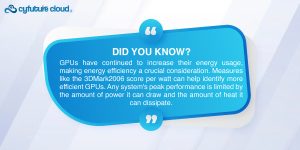
The future of GPU cloud server is focused on improving performance per watt, increasing energy efficiency, and enhancing their capabilities for general-purpose computing. The evolution of GPUs has been significant, and their applications continue to expand into various fields, making them an essential component of modern computing.
What is TPU Cloud?
A Tensor Processing Unit (TPU) is a specialized hardware accelerator designed by Google specifically for accelerating machine learning tasks. It excels in operations common to neural networks, such as matrix multiplications. TPU cloud offer enhanced performance and efficiency compared to traditional CPUs and GPU cloud. They are deeply integrated with Google’s TensorFlow framework, enabling rapid training and inference of AI models.
History and Development
The development of TPUs began in 2013 when Google recognized the need for more efficient hardware to power its vast array of AI-driven services. They took the initiative to design the TPU, which was not just about creating a faster chip but about reimagining the foundation of AI computation. Through their pioneering efforts, Google elevated their AI capabilities and set a new standard in machine learning hardware.
Architecture and Functionality
TPUs are ASICs (application-specific integrated circuits) used to accelerate specific machine learning workloads using processing elements—small DSPs with local memory—on a network so these elements can communicate and pass the data through. They have libraries of optimized models and use on-chip high bandwidth memory (HBM). Each core has scalar, vector, and matrix units (MXUs). The MXUs do the processing at 16K multiply-accumulate operations in each cycle. 32-bit floating point input and output is simplified via Bfloat16. Cores execute user computations (XLA ops) separately. Google offers access to Cloud TPUs on their servers.
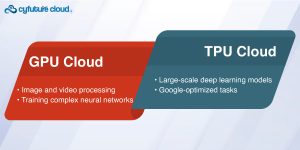
Applications and Use Cases
TPU cloud have found their way into various applications, particularly within Google’s ecosystem. They have also been used in:
- Image recognition and processing
- Natural language processing (NLP)
- Healthcare and medical imaging
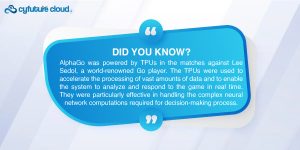
Performance and Efficiency
TPU cloud offer significant improvements in performance for machine learning tasks compared to general-purpose processors like CPUs and GPUs. They are particularly efficient for machine learning tasks due to their high volume of low-precision computation. The latest Google TPU contains 65,536 8-bit MAC blocks and consumes so much power that the chip has to be water-cooled. The power consumption of a TPU cloud is likely between 200W and 300W.
The future of TPUs is focused on improving performance per watt, increasing energy efficiency, and enhancing their capabilities for general-purpose computing. TPUs have evolved significantly, and their applications continue to expand into various fields, making them an essential component of modern computing.

Key Differences Between GPUs v.s TPUs
GPU cloud and TPU cloud are powerful tools for machine learning and deep learning tasks but have distinct differences. Let’s have a quick look at some of them:
Architecture and Design
GPU cloud are built as general-purpose processors designed to handle various tasks, including:
- Graphics rendering
- Video editing
- Cryptocurrency mining
They are composed of thousands of cores, each capable of performing multiple tasks simultaneously. This makes them highly parallel processors. This parallelism enables the GPU cloud server to handle complex tasks efficiently.
TPU cloud, on the other hand, are custom-built ASICs designed specifically for deep learning and machine learning tasks. They are optimized for matrix operations and neural network workloads, which are the core components of these tasks. TPU cloud are designed to handle large-scale deep-learning models and are particularly efficient for:
- Natural language processing
- Google-optimized tasks
Processing Capabilities
GPU cloud are known for their high computational power and parallelism. They can perform thousands of tasks simultaneously, making them ideal for tasks that require massive parallel processing. However, this parallelism comes at the cost of high energy consumption and memory access latency.
TPU cloud, by contrast, are designed to handle tensor-centric processing. They are optimized for matrix operations and neural network workloads, which are the core components of deep learning tasks. TPUs are highly efficient for tasks that involve large-scale matrix multiplications and are particularly well-suited for tasks like:
- Natural language processing
- Google-optimized tasks
Performance Benchmarks
Performance benchmarks for GPUs and TPU cloud vary depending on the task and scenario. In general, GPU cloud are faster for tasks that require high parallelism, such as:
- Image Processing
- Video processing
On the other hand, TPUs are faster for tasks that require high matrix operations, such as:
Large-scale deep learning models
For example, a study by ar5iv found that TPUs achieved 2x FLOPS utilization for CNN models and 3x FLOPS utilization for RNN models compared to GPU cloud. Another survey by Kaggle found that TPUs were 15 to 30 times faster than current GPUs for performing a small number of predictions.
Use Cases and Applications
GPU cloud are suitable for tasks that require high parallelism, such as:
- Image and video processing
- Training complex neural networks
TPU cloud are suitable for tasks that require high matrix operations, such as:
- Large-scale deep learning models
- Natural language processing
- Google-optimized tasks
Cost Analysis
The best GPU cloud server providers offer more affordable solutions than TPUs, especially for cloud-based services. However, TPUs offer better value for tasks that require high matrix operations and neural network workloads. For example, a study by ar5iv found that TPUs achieved 2.5x performance improvements for CNN models and 7x for FC models compared to GPUs.
Ease of Use and Accessibility
GPU cloud are generally easier to set up and integrate than TPUs. Many cloud providers offer pre-configured GPU instances that can be easily deployed and managed. TPUs, on the other hand, require more specialized knowledge and setup, as they are designed for specific deep-learning tasks.
Software & Framework Support
Software and framework support for GPU cloud servers is also more extensive, with libraries and frameworks like TensorFlow and PyTorch optimized for GPU acceleration. TPUs, while supported by Google’s TensorFlow framework, require more specialized software and frameworks optimized for TPU acceleration.
|
Aspect |
GPU Cloud |
TPU Cloud |
|
Architecture |
Designed for parallel processing with thousands of cores optimized for graphics and general-purpose computing. |
Specialized for tensor operations, with matrix processing units optimized for large-scale deep learning tasks. |
|
Performance |
Excellent for a wide range of machine learning tasks, especially those involving heavy graphics processing. |
Superior performance for specific deep learning models, particularly those optimized for TensorFlow. |
|
Cost |
Generally more expensive for on-demand instances; lower cost for long-term commitments. |
Cost-effective for large-scale training but can be less flexible and more expensive for smaller tasks. |
|
Use Cases |
Ideal for image and video processing, training diverse neural networks, and high-performance computing. |
Best for large-scale deep learning models, such as those used in NLP and computer vision tasks. |
|
Ease of Use |
Wide support from many cloud providers and integration with popular ML frameworks like TensorFlow and PyTorch. |
Optimized for Google’s TensorFlow, with more limited support for other frameworks. |
|
Software Support |
Compatible with a variety of ML libraries and frameworks, providing flexibility for different projects. |
Primarily optimized for TensorFlow, with growing but still limited support for other libraries. |
|
Scalability |
Highly scalable with extensive availability across major cloud providers (AWS, Azure, Google Cloud). |
Scalable within Google Cloud Platform, with specific infrastructure designed for large-scale training. |
|
Energy Efficiency |
Typically consumes more power due to its general-purpose nature and extensive core count. |
More energy-efficient for specific tensor operations, leading to potential cost savings in large-scale applications. |
|
Deployment |
More complex setup due to versatility but widely supported and documented. |
Simplified deployment for TensorFlow models on Google Cloud, with managed services reducing setup complexity. |
|
Community and Support |
Large community with extensive resources, tutorials, and support from various cloud providers. |
Strong support from Google, with an increasing but smaller community compared to GPUs. |
Case Studies and Real-World Examples
GPU-Based Applications in Machine Learning
- Pinterest’s Deep Learning Infrastructure
Pinterest uses NVIDIA’s Tesla V100 GPUs to accelerate deep learning workloads, achieving a 3x speedup in training and inference tasks compared to CPUs.
- Adobe’s GPU-Accelerated Deep Learning
Adobe leverages NVIDIA’s Tesla V100 GPUs to accelerate deep learning tasks, such as image recognition and natural language processing, by up to 10x compared to CPUs.
- NASA’s GPU-Based Deep Learning
NASA uses NVIDIA’s Tesla V100 GPUs to accelerate deep learning tasks, such as image recognition and object detection, by up to 5x compared to CPUs.
TPU-Based Applications in Machine Learning
- Google’s TPU-Based Deep Learning
Google uses TPUs to accelerate deep learning tasks, such as image recognition and natural language processing, by up to 15x compared to using CPUs.
- Cloud-Based TPU Use Cases
Cloud providers like Google Cloud offer TPUs for machine learning tasks, such as image recognition and natural language processing, which can be up to 15 times faster than CPUs.
- Real-World Impact on Model Training
TPUs have significantly impacted machine learning projects, showcasing their efficacy in various applications, such as image recognition and natural language processing.
How to Choose Between GPU and TPU?
When choosing between GPUs and TPUs for machine learning projects, there are several key factors to consider:
Performance and Workload
TPU cloud excel at tensor operations and are optimized for large-scale neural network training and inference. They offer exceptional performance for tasks like natural language processing and image recognition.
The best GPU cloud server are more versatile and can efficiently handle a wider range of machine learning workloads. They are well-suited for tasks like image and video processing.
Evaluate your specific workload requirements and the types of neural networks you’ll work with to determine which hardware is best for you.
Cost and Availability
TPU cloud are primarily available through the Google Cloud Platform, which may not be suitable for all users and organizations. They can be more expensive than GPU cloud.
GPU are more widely available from various GPU cloud server providers and hardware vendors. They offer a range of price points to fit different budgets.
Consider your budget, cloud provider options, and whether you need to run on-premises or in the cloud.
Energy Efficiency
TPU cloud are designed to be more energy-efficient than GPU cloud, focusing on reducing power consumption per operation. It makes them a better choice for large-scale deployments.
GPU cloud typically consume more power and generate more heat, which can be a concern for energy costs and cooling requirements.
If energy efficiency and power consumption are critical factors, TPUs may be the better choice.
Ecosystem and Tooling
GPU cloud server benefit from a mature ecosystem with extensive software and tools, such as CUDA, cuDNN, and popular deep learning frameworks like TensorFlow and PyTorch.
TPU cloud have a less mature ecosystem, with fewer software options and tools available. However, they are well-integrated with TensorFlow.
Consider the tools and frameworks you already use or plan to use and how well they support each hardware option.
Technical Expertise
GPU cloud are more widely used and understood, and there is a larger community and more resources available for learning and troubleshooting.
TPUs may require more specialized knowledge and expertise, especially if you work with them directly rather than through a cloud platform.
Assess your team’s technical skills and the learning curve associated with each hardware option.
In a Nutshell

Choosing between GPU Cloud and TPU Cloud for your machine learning needs is a critical decision that can significantly impact your project’s:
- Performance
- Cost-efficiency
- Scalability
GPU cloud servers offer versatility and widespread support across various machine-learning frameworks. It makes them ideal for tasks like image and video processing, general neural network training, and high-performance computing. On the other hand, TPU cloud, with their specialized design for TensorFlow-based models, excel in large-scale deep learning tasks, providing exceptional performance and efficiency for tensor-centric operations.
As you consider your options, you must weigh factors like cost, ease of use, energy efficiency, and the specific needs of your machine learning workloads. GPUs and TPUs have revolutionized AI and machine learning, but selecting the right one for your unique requirements will ensure optimal results.
For those seeking reliable and scalable GPU cloud server solutions, look no further than Cyfuture Cloud.We are best GPU cloud server providers that offer unparalleled performance and flexibility for all your machine learning needs. Whether you are training complex neural networks or processing high-resolution images, Cyfuture Cloud provides the robust infrastructure and support you need to succeed.
Visit Cyfuture Cloud today to explore our GPU cloud hosting options and take your machine learning projects to the next level!
Recent Post
Send this to a friend

 Server
Colocation
Server
Colocation CDN
Network
CDN
Network Linux
Cloud Hosting
Linux
Cloud Hosting Kubernetes
Kubernetes Pricing
Calculator
Pricing
Calculator
 Power
Power
 Utilities
Utilities VMware
Private Cloud
VMware
Private Cloud VMware
on AWS
VMware
on AWS VMware
on Azure
VMware
on Azure Service
Level Agreement
Service
Level Agreement 

















